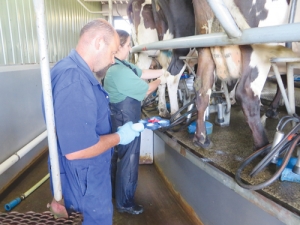Our moderate climate and pastoral farming model gives us a lower mastitis risk than other dairy countries, but DairyNZ still estimates mastitis costs the average farmer a whopping $54,500pa.
Mastitis has a massive effect on milk quality, with an impact on the bulk tank somatic cell count (SCC) affecting further processing. Some milk buyers around the world are offering bonus payments for low somatic cell count milk - which is an excellent incentive for farmers to ensure their milk is of high quality.
SCC is also an important marker in your general herd health - cows without mastitis produce more milk.
Bulk tank somatic cell count is not a reliable indication of mastitis problems on the farm as a lone measurement. For example in a similar size herd one farmer may have a bulk tank SCC of 80,000 with all of the cows milking. His neighbour may have the same count, but with 30 cows under treatment.
One farmer is managing his mastitis, the other is preventing new cases of mastitis because he doesn't have any.
Could we do better with mastitis? Absolutely we can. Mastitis has no respect for payout prices.
How do cows get mastitis? Where do the problems come from and how can you prevent mastitis in your herd?
The latest National Mastitis Council conference in Syracuse, New York included both conference lectures from mastitis researchers and professionals from around the world and local farm tours with frank and honest discussions with farmers about where their issues came from.
The tours covered two high-tech Lely robotic farms as well as a large De Laval 100-bale rotary shed.
Common to these farms was mastitis, but it is becoming widely realised that mastitis can't all be categorised as the same - when the causes of the disease can be very different. With information comes knowledge, and identification of the pathogens involved in each case of mastitis is critical in management and prevention of the disease, and treatments used. Like leaving a signature, each pathogen has a unique style, place it hangs out and also weaknesses.
So-called emerging pathogens that were discussed at the conference may have always been there - but what has changed is that more measurement is done around mastitis, whereas just a few years back little was known about the disease.
New Zealand leads the way in many innovations in the dairy industry and we have enviable conditions for dairying in general. Europe, however is leading the charge on reduction of agricultural antibiotic use. Practices like dry cow are under scrutiny and this was a heavy discussion topic at the conference.
Studies conducted both in New Zealand and overseas show that cows without pathogens in the udder at dry off have no higher risk of mastitis than cows that are treated with dry cow therapy.
Understanding the nature of bacteria helps to reduce the number of new infections. Whilst we can't see bacteria, they tend to have places they like to hang out.
Some of the bad guys — if bacteria were people:
Staph aureus
Like a stalker contagious, sinister, devious, hangs out in noses and on people's skin. Spread via milking cow-to-cow by cross infection, and from workers to cows during milking, rushed teat sealing and dry cow. Control: clean hands, effective post milking teat spraying, identification of infectious cows and milking them last, not feeding milk from these cows to calves.
Difficult to cure and to control, be very vigilant - does not always cause clinical mastitis, but causes a lot of udder damage. Most agree that weeding these cows out of the herd is a good move. Often infections are sub-clinical and remain undetected for a long time so staph avoids culls this way.
Strep uberis
Like a messy teenager - loves a mess, always hanging around; environmental - hangs out in muddy and dirty environments in large groups such as feed pads, under trees in summer, dirty raceways and loves cows that have to walk through manure. Dirty cows increase risk of infection. A hard one to control if it's messy.
Strep dysgalactiae
Sneaky opportunist, semi contagious but generally easy to send on its way if discovered; loves damaged teats.
Pseudomonas
Slimy creep, hates dry, clean and sunshine. Hides in dark wet places or areas contaminated with splashes from places such as dirty drains, dirty teat salve, dirty teat wipes or dirty wet areas in the shed. Can be spread from water - eg hosing around cups off. Can be serious and sometimes fatal. Very resistant to treatment.
E. coli
Jekyll and Hyde - mild or mean- spread from the gut in manure, may be prevalent in low grade cases all season and around mating times. Means exposure to manure somewhere. Can cause serious mastitis in some cases. Keep teats away from manure to avoid this one.
Serratia and Enterobacter
Hillbilly - Lounges in the sawdust, rotten wood or the barn, loves straw, drains, effluent and is shed from the gut in manure. Can survive and has been found in contaminated diluted teat sprays. Can be contagious from cow to cow during milking. Didn't mean to cause a problem, but if it gets in can cause long and chronic cases of mastitis.
CNS
Mischievous big brother and sometimes possibly protective like a practical joker- from the cow's own skin, this opportunistic bacteria is thought to be harmless, and transient, not normally requiring treatment. In some studies, including one in NZ, cows with CNS produce more milk. It is now thought that where implicated in mastitis, CNS may be found but is not the agent causing the infection. Control new infections by keeping great teat condition and cracking down on post milking teat spraying.
Mastitis symptoms include:
Elevated Somatic Cell Count (SCC)
The first symptom as the cow's immune system activates to fight and to clean up any infection. This elevation will persist for a short time even when the bacteria are eradicated - like cleaning up after a party. Detection methods such as individual cow or quarter in-line conductivity and somatic cell counting systems and herd testing can tell you which cows have an elevated SCC at the time of measurement. This does not tell you, however, what ails the cow or if she needs treatment of any sort.
Abnormal milk
(flakes, strings, clots) - NB: this is only present in clinical cases of mastitis or more advanced stages. Many cases of mastitis can be subclinical and go undetected in the herd- but still be infectious.
Other symptoms - acute and peracute
may be swelling or hardness in one or more quarters of the udder. Fever, dehydration, depression or very sick cow. Cows like this can be tested, but should be treated without waiting for results or delay.
Treatments for mastitis
Measurement is critical in successful treatments. Like any disease we need to know the cause before we can nail it. Blind treatments of cows at any stage of mastitis other than very sick cows is literally stabbing in the dark. Some pathogens, if not targeted correctly the first time will flare up again and are less likely to resolve, even spreading in the meanwhile. Don't assume your mastitis is caused by anything you haven't measured, you could end up chasing your tail and seeing the same cow, and her friends with mastitis again.
So how do you know when to treat and when not to treat, or what to use?
All drugs have uses and benefits, but the success of such treatments depends on factors which need to be established. The development of protocol around drug use between the farmer and the vet is essential for reducing the incidence of mastitis in your herd, as well as increasing the success of the outcomes when treatments are used. The most expensive treatments are not necessarily the best without knowing what you are dealing with.
Where to start
On-farm culture is a piece of the puzzle that hasn't been available until recently. Most vets realise the need for the identification of the pathogens involved in cases of mastitis, but until recently this meant sending samples off, with even the best turn-around times being three days and many being two weeks. Simply, nobody should or could wait that long. This lead to a common practice of freezing milk samples "in case" so that if the case didn't resolve, it could be tested. That was in the absence of something better, and now we have something better- on farm culture is a huge step forward and a gold standard in mastitis identification and management. Available seven days a week and at a reasonable cost without a trip to town or a courier, the results are available in 24 hours.
A simple system that involves a level of hygiene comparable to dry cow therapy, even the most inept are likely to improve their mastitis outcomes using on farm culture.
Using technologies to identify abnormal milk, cows with high somatic cell counts as well as clinical cows can be found. RMT/CMT can be used to find affected quarter/s. These cows can be cultured using an on-farm culture system like CHECK-UP. Whilst subclinical mastitis may not always be economic to treat, SCC problems can escalate quickly and be frustrating to resolve. Infection risks with pathogens can be controlled and patterns can be established where trends exist, for example teat spraying inadequacies.
Work with your vet
Your friendly vet is really trying to help you. Sometimes it is hard for them to know how. With your farm and your pathogens your vet can help establish protocol on farm for treating your mastitis problems. Your vet is the only one that can prescribe drugs for your farm and each farm has its own unique sets of issues.
On farm culture gives great information that can be used to generate such protocol. It also assists greatly in identifying where problems are coming from and helping you to reduce risks on your farm to prevent new cases. Your risks can be from infectious bacteria spreading during milk harvesting, a worker milking with cracked and dirty hands, teat spraying that isn't effective to a dirty feed pad that your cows are lying down on. Measurement of your mastitis bugs gives you the information on where to look, and patterns are important for prevention of further cases.
Your vet can adapt your treatment protocol until it is a well-oiled machine, seeing you saving money, drugs, time and milk.
Mastitis prevention
Five years ago this would have evoked thoughts of dry cow therapy. Several studies in NZ and abroad have shown that cows with no major pathogen present at dry off have no increase in risk of developing mastitis than cows that are treated. So how do you know when a cow has a major pathogen present? Herd testing and milk testing in line are great indicators of a cow's immune response status, and on-farm culture can be used to establish if the pathogen is still present.
Herds with Staph aureus problems can also be herd screened to help identify the cows for herd management.
Prevention focusing on the weakness and origin of the pathogen is your best chance at winning in reducing your mastitis cases and your bulk tank SCC.
Risky behaviour:
Cracked teats and teat condition
Of course cracked or damaged teats provide a direct line to the udder and an easy path for the bad guys - check your teat spray, and milking machine function if you see spots, misshapen teats and be careful about over or under milking cows.
Teat spraying
How are you making up and storing your teat spray? What is your water quality like do you have E. coli and algae in your water? Teat sprays made with poor quality water or stored in open, dirty conditions can become contaminated and infect cows. Lack of effective spraying is also an invitation for bacteria from even your cow's own skin to take hold whilst the teat canal is open.ω


















